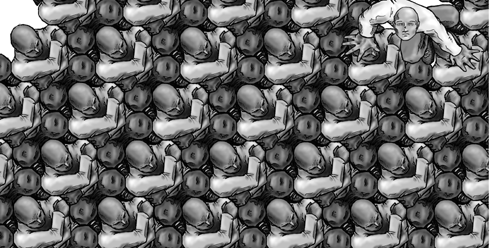
LETTERS TO THE EDITOR
Diversity in Art Education: A Question of Ethics
Ethics: The discipline of philosophy concerned with
what is morally good and bad, right and wrong.”
—Encyclopedia BritannicaAmong other things, artists are observers, recorders, creators, seekers, commentators, collectors, and reflections of society. And like anyone else, artists are incapable of completely transcending fear, bias, prejudice, ignorance and naiveté. As members of society, artists are labeled “cultural producers,” “rabble rousers,” “political activists,” “social outcasts,” “social hob-nobbers,” “egoists,” “creative geniuses,” and the list goes on. In reality, though, others (both artists and non-artists), assign artists with various labels. We as individuals in the end (when arts publications are closed and the galleries and museum lights dim) are left to define ourselves.
For many of us, an aspect of this self-definition involves our academic training. We hope that our training will provide us with the space and time to develop our voices as artists and our vision for our art. It is obvious that an art education aims to teach us technique, art conventions, art history, and, if we are lucky, possible career skills. But more than that (which, based on the last F News responses to the question of diversity, seems less and less obvious), successful public artists are thoughtful and engaging. After all, technique can be self-taught through experimentation and book learning. It would be fabulous if we all learned more about how to communicate with one another and hopefully how to engage audiences about the art we create. Issues of art standards and philosophical approaches to art aside, it would benefit us as a society to hone our skills as critical thinkers and ably participate in society. We can’t afford to not look outside of ourselves, for audiences, admiration, and funding, without at the same time being socially responsible and consciously engaging. Not to mention, singularity in anything — especially thought — is suffocating, and in the universe of ideas, minute. It would be quite an accomplishment if we could expand what we know, not in a single direction, but in multiple directions. In other words, we must expand our possibilities beyond a Eurocentric and phallocentic worldview.
A Word on Diversity
I don’t know a place that is more DIVERSIFIED than the United States of America. It should really be obvious why students at SAIC don’t really care about diversity, but I’ll share the secret ... we are already diversified. Perhaps it is not obvious enough to those living outside the dorms, but the dorms at SAIC are so diverse that on any given day and hour the doors are all shut, and for the most part the halls remain silent unlike other colleges in Chicago. And you want to know why? It is because we come from all over the world; we all speak different languages! Students here care about making good work; they also care about networking and making a few friends in the small amount of spare time they have, despite the extremely high dropout rate after the first year.
As far as diversifying the faculty, I think the school should be more concerned about hiring teachers who have the ability to teach. The school should want to know if these teachers have patience, if they have good communication skills, and the skills to teach someone else the knowledge they already have in an understanding and logical fashion.
I don’t appreciate what the school is trying to be: politically correct. Interestingly, students here are completely numb to that kind of bullshit, especially those of us who grew up in the U.S.A. and have been dealing with it all our lives. We will simply turn the other cheek.